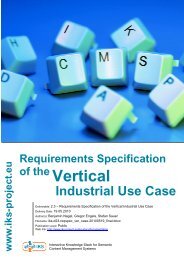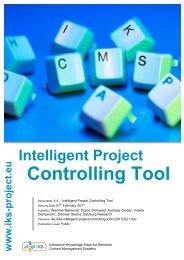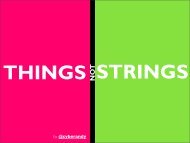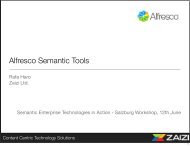Work Plan in Detail - IKS
Work Plan in Detail - IKS
Work Plan in Detail - IKS
You also want an ePaper? Increase the reach of your titles
YUMPU automatically turns print PDFs into web optimized ePapers that Google loves.
Ma<strong>in</strong> Innovations<br />
In order to support the transition to a<br />
truly knowledge based economy, we<br />
must move our current support technology<br />
from a content-based technology<br />
to a semantics-capable technology,<br />
and we must do so not just for the big<br />
players, but we must conv<strong>in</strong>ce European<br />
SMEs that this is a worthwhile journey<br />
to take. This is expressed <strong>in</strong> the mission<br />
statement:<br />
Interactive Knowledge creates a<br />
technology platform for semantically<br />
enabled content and knowledge<br />
management, targeted at small to<br />
medium CMS technology providers.<br />
This overall mission entails a number of<br />
necessary <strong>in</strong>novations which do not<br />
seem to have been <strong>in</strong> the focus of research<br />
on Intelligent Content and Semantics,<br />
so far:<br />
• There are very advanced technology<br />
platforms such as semantic<br />
web services and there are even<br />
comb<strong>in</strong>ations of these advanced<br />
service architectures with GRID<br />
architectures, but there has not<br />
been much research <strong>in</strong>to what<br />
stops current CMS technology<br />
providers from buy<strong>in</strong>g <strong>in</strong>to semantic<br />
technologies. Interactive<br />
Knowledge will provide a seman-<br />
“A-B-C People”<br />
Doug Engelbart's far-sighted vision about technologies<br />
for knowledge workers that enable users<br />
“downstream” to be more productive stands at the<br />
beg<strong>in</strong>n<strong>in</strong>g of this project.<br />
tically enabled<br />
layered CMS/<br />
KMS architecture,<br />
its specification<br />
and a<br />
reference implementation - the<br />
Interactive Knowledge Stack.<br />
• There has been excellent research<br />
work <strong>in</strong>to foundations of ontological<br />
representations, and there<br />
are large scale workbenches for<br />
ontological eng<strong>in</strong>eer<strong>in</strong>g, but there<br />
have not been many attempts to<br />
make foundational ontologies usable<br />
by commercial software developers<br />
and there has been even<br />
less research <strong>in</strong>to develop<strong>in</strong>g user<br />
<strong>in</strong>terfaces which let end users <strong>in</strong>teract<br />
with knowledge structures<br />
<strong>in</strong> an <strong>in</strong>tuitive<br />
fashion. InteractiveKnowledge<br />
will provide<br />
a layered,<br />
semantically<br />
enabled user <strong>in</strong>terface framework<br />
which can be customised by software<br />
developers of CMS applications<br />
so that end users can <strong>in</strong>teract<br />
with knowledge-rich content<br />
<strong>in</strong> an <strong>in</strong>tuitive way.<br />
4<br />
What stops current CMS<br />
technology providers from<br />
buy<strong>in</strong>g <strong>in</strong>to semantic<br />
technologies?<br />
How can end users <strong>in</strong>teract<br />
with knowledge-rich<br />
content <strong>in</strong> an <strong>in</strong>tuitive<br />
way?










